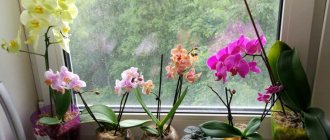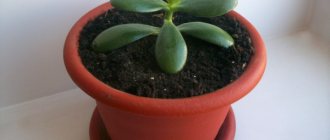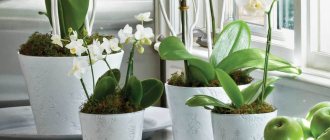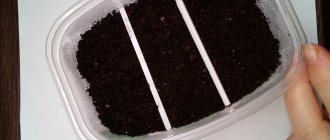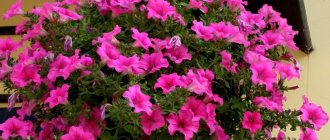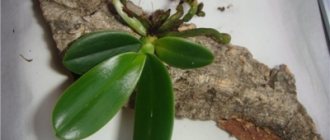The variety of varieties of this beautiful and delicate flower is difficult to convey in words. Miniature and large, double, small-flowered, large-flowered, floribunda, ampelous and surfinia - the first difficulty a gardener faces is the need to choose a seed variety. After all, you still need to decide on the color of the future decoration of the garden or balcony.
The colors of long-flowering petunia look like the result of an artist’s imagination. They come in pure white or with streaks, lemon, lilac, all shades of pink, scarlet and burgundy, with spots, stars and stripes. Proper planting and care of petunia, photos of which are presented below, depend on the place where it is grown: in a pot on the balcony and on the street or in open flower beds.
How to plant ampelous petunia in a flowerpot
There are several types of petunia; the ampelous petunia differs from others in its stems descending to the ground. Usually it is planted in a hanging pot, so the clusters of buds look more impressive. The plant, despite the noticeable successes of breeders, remains quite capricious to care for. Fortunately, by following simple rules, you can successfully plant a young flower.
Petunia is ideal for decorating a loggia garden
Rules and techniques for planting ampelous petunia in flower pots
Planting ampelous petunia in a flower pot is a step-by-step process; before this, the seedlings are prepared. Planted at the end of February, by the beginning of June it is ready to be transplanted into a pot. A hanging planter must have a tray - petunias love water.
Note! The grown plant will weigh a lot, and with soil even more - the material of the container must be durable.
The pot for petunia should be the right size for it.
Before planting you need to prepare the soil:
If the composition is too dry or the air humidity is low, you can add hydrogel to the soil.
Important! Immediately after planting, it is not recommended to expose the pot with the seedling to the open air on the sunny side. Sowing is done in winter, and planting is done closer to May. The plant must get used to the new place in a calm environment.
Ampel varieties of petunias are distinguished by a variety of colors
You can also purchase a ready-made substrate for growing petunia, choosing the option for a specific variety. Before pouring into the pots, the soil must be disinfected. After placing the seedling in the ground, you need to distribute the soil well; there should be no voids between the roots. You should not press down the soil too much; this will negatively affect the condition of the root system.
What volume of pots is needed for hanging petunia?
In this regard, it is difficult to formulate a general rule; much depends on the plant variety, the number of bushes in the pots and other factors. For small single compositions, a 5-liter pot is sufficient, for larger ones - up to 10 liters.
Note! If two varieties of petunias with voluminous flower heads will grow in one pot, you can consider the option of a wide flowerpot.
How many ampelous petunias should be planted in one flowerpot?
The desire to grow a lush head of buds leads to the obvious question of the number of plants in one pot. There is an opinion that it is wrong to plant more than one, the roots will intertwine, and nothing good will come of it. At the same time, other gardeners claim that there can be 2-3 petunias in one pot. Their roots must be positioned so that they do not intertwine. That is why, through trial and error, successful combinations of different varieties were obtained.
The number of petunias in one pot depends on the variety
The problem is that hanging plants tend to grow, and the lower part of the plants does not receive enough oxygen. In this case, you will have to pinch and shape the petunia, and also monitor the condition of the soil.
Growing and caring for pots
Petunia loves sunlight, warmth and regular watering, and her care is built around this. The soil in the pots should not dry out; it must be watered constantly. Petunia blooms for a long time, it needs enough moisture. But you can’t flood the plant; the roots may begin to rot. In summer, more intensive watering is needed, in winter - moderate.
Important! The soil in the petunia pots should always be moist (not wet).
The plant loves the sun, it needs to be grown on the south side, since constant exposure to the shade will greatly harm it. The optimal temperature during flowering is 23-27 °C. It tolerates minor changes quite easily. During flowering, one should not forget about feeding.
Properly cared for petunia produces a lush head of large buds
Petunia is resistant to diseases and pests, and if infection does occur, it tolerates treatment well. It is important for the grower to quickly detect the problem and take the necessary measures. The better he takes care of her, the less likely it is to become infected.
Important! Fungicides are used to treat diseases.
Dangerous pests for ampelous petunia are aphids, spider mites and slugs. Spraying with a soap solution gives a good effect; the previously diseased plant must be isolated from others.
Bush formation
The first thing you need to know when planting petunia in a pot is that it grows a lot. That is, the shoots create a huge head, leaving the stems bare, and the plant looks unattractive. At the same time, the root system spends all its energy on the foliage, and the buds turn out small and dull. The problem can be solved by pinching - removing unnecessary shoots. You should remove 2/3 of the length; new shoots will grow in place of the previous shoots. This way the head of buds will prevail over the foliage and look harmonious.
With proper pinching, you can get a spectacular composition from different varieties of petunias.
Varieties
Ampelous petunia "Tidal wave" is a completely separate type of flower, which is called "Giant Petunia".
"Tidal Wave Silver"
One of the tallest bushes of the wave subspecies, dotted with flowers, with long stems 110–115 cm. The buds themselves are 5–7 cm in diameter, have different shades: white, light purple, bright lilac, red. The bush of this variety can grow 55 cm in height and up to 1.5 meters in diameter. Since the Tidal Wave Silver petunia grows over a fairly large area, it is immediately clear that it loves freedom.
Tidal wave red velor
A fast-growing ampelous petunia, great for growing at home, as well as for the landscape. The height of the fiery red beauty is on average 55 centimeters, the flowers are 6 centimeters in diameter. Withstands weather changes and diseases. One of its bushes can occupy an area of one or more meters.
If the plant is planted in flowerpots, it is recommended to use a container of at least 30 liters in volume. The soil for planting should be loose, to which the following is added in equal parts:
- sand;
- humus;
- peat;
- turf land.
This variety really loves illuminated planting sites - you need to take this into account. Main rules:
- fertilize periodically;
- moisturize, but do not flood;
- cut off faded flowers and leaves;
- sometimes loosen the soil at the roots.
"Tidal wave cherry"
An annual plant, the height of the bush is from 35 to 70 cm. The diameter of the flowers is 6 cm, bright pink. Perfectly decorate a balcony, loggia, fill large flowerpots. Tolerant of cold or hot weather, loves moisture.
Simple rules of care:
- loosen the top layer of soil from time to time;
- fertilize if possible (this will prolong the flowering period);
- remove all dry shoots;
- trim off faded buds, which will promote good growth of neighboring ones;
- keep the soil moist.
"Tidal Wave Parple"
A tall bush - about 60 cm, dotted with many magically pink flowers with a diameter of 5-7 cm. Most often used for landscape design, it has strong shoots and adapts well to different weather conditions. The length of the sprouts is 90–110 cm with a probability of growing up to 1.5 meters to the sides.
When keeping this petunia, the following recommendations should be followed:
- fertilize the plant as often as possible, which is necessary for abundant and long flowering (especially often you need to fertilize the soil if the flowers grow in flowerpots);
- if growing occurs in a flowerpot, then the volume of the container must be at least 30 liters;
- It is best to add to the soil for planting: peat, sand, perlite, which will provide protection and good growth of petunia;
- do not forget about hydration - petunias love moisture;
- If necessary, trim off dried leaves and flowers.
"Tidal wave hot pink"
The annual petunia "Hot pink" is also famous for its many flowers with a diameter of 6 centimeters, the height of the bush is up to 55 centimeters. It has hard shoots, which ensures safety in difficult weather conditions and protects against diseases. Their length is 80–110 centimeters, the bush itself can grow up to 1.7 meters in diameter.
"Tidal shock wave"
Early ampelous petunia with particularly rapid growth. It grows up to 18 cm, the length of the stems is up to 85 cm, the diameter of the flowers is 4–5 cm. The flowers are the smallest compared to other petunias. “Shock Wave” blooms very luxuriantly and is quite resistant to fragility. The color of petunia can be: snow-white, dark blue, pink, yellow. Flowers may be double to the touch.
Loves hot and humid climates. But if this cannot be ensured, then the bush will not stop blooming and delighting due to its endurance to the surrounding growing conditions. Care requirements include the following:
- loosening the top layer of soil at the roots as often as possible;
- fertilizing with fertilizers at least once a week;
- you can trim the bush if you want to create a shape;
- timely removal of fading flowers;
- removing dried branches and leaves.
Varieties of ampelous petunias for hanging flower pots
The following varieties are best suited for a hanging flowerpot.
Avalanche
A popular variety that differs from others in its upright young shoots. As they grow, they bend under the weight of the shoots. The buds are large, the scattering turns out to be an avalanche. The color of the petals is varied: from pastel to intense shades.
Velveteen
A Czech variety with a height of 80-100 cm. It is used not for flowerpots, but as a flower garden decoration. The carpet reaches a height of 25 cm and looks amazing for large areas.
For your information! An additional purpose is to create flower trees.
Shock Wave
A suitable variety for unfavorable weather conditions, as it is resistant to cold and strong winds. Shock Wave blooms early, the buds are noticeably smaller than those of other petunias, this also applies to the leaves.
Opera
A Japanese variety, the characteristics of which are unpretentiousness and lack of reaction to the length of daylight hours. Due to its small flowers and height up to 1 m, it is used in flowerpots and carpets for flower beds.
Petunias look amazing even in plain colors
Ampelous petunias are considered very beautiful flowers for the home garden. This seems fair, because wavy branches with gramophones will decorate any balcony. They can be planted in pots - a popular option - or used as a carpet for a flower bed. The choice of purpose depends on the specific variety, its height and bud size.
Source
Possible problems
And although Tidal petunia is easy to grow, novice gardeners may encounter the following problems:
- When growing petunia, you need to protect it from strong winds and rain. If this is not done, the decorative appearance of the plant is disrupted, since the delicate petals are injured due to bad weather.
- Petunia will not bloom and grow profusely if planted in an insufficiently sanctified place. Over time, it will wither and may even die.
- In areas where there is prolonged rain in the summer, plant petunia only if there is good drainage. Otherwise, the plant will die due to high humidity.
Petunia Tidal is an interesting hybrid that is gaining popularity among gardeners every year. Its peculiarity is a wide palette of shades and versatility in terms of application. You can plant a bush in a flowerbed, in a flowerpot, cache-pot or pot. When creating adequate conditions for growth and development, the bush will be literally strewn with bright and large flowers.
If you find an error, please select a piece of text and press Ctrl+Enter.
Today, petunias are perhaps the most popular flowers in the gardening world. They have won the hearts of many with their resistance in any weather, ease of planting, as well as a large selection of species, varieties, and colors. One of the commonly used species is Tidal Wave petunia.
Features of caring for ampelous petunias
Hanging petunias decorate balconies, terraces, and gazebos in dachas.
In order for the area to drown in the lush flowering of these plants, it is necessary to follow the most basic rules of care:
Since summer residents like to grow petunias in open areas, care must be taken to ensure that the flower is not susceptible to attack by pests such as spider mites, aphids and snails.
Important! For preventive purposes, the green beauty should be watered with a weak solution of potassium permanganate.
Flowers should be sprayed with soap or tobacco solution against aphids and spider mites. To prevent snails from reaching the plants, you need to cover the soil around them with stones or eggshells, as they prevent the movement of these pests.
As for diseases, petunias are susceptible to mold, which can lead to rotting of the roots. To prevent this from happening, for preventive purposes, the soil is mixed with sand before planting, but this method does not provide a 100% guarantee that mold damage will be avoided. To combat this disease, potassium permanganate is used, which is mixed with water.
To avoid diseases such as chlorosis, it is necessary to add iron to the water. This is especially important for white petunias, which most often suffer from this disease.
Common diseases and pests
The following diseases can affect Tidal petunia:
- Late blight. This is a fungal disease that can be recognized by its dark stem. If the plant is not treated in a timely manner, the bush will die. The main reason for the development of the disease is high humidity and insufficient lighting.
- Gray rot. This disease is formed as a result of improper watering and sudden temperature changes. As a result, a light brown coating forms on the leaves. Every day the size of the spots will increase.
Among the pests, the following are particularly dangerous:
To combat them, systemic insecticides are used.
Growing petunia from seeds
This flower has very small seeds. In order for them to sprout, they need to be provided with nutritious soil. The soil should be light, loose and neutral acidity.
Important! Petunia seeds are sown from February to April. However, March is considered the ideal time. Plants planted this month will produce abundant flowering in June.
For sowing, a shallow wide container is suitable, which is filled with soil, leaving a small (about 1 cm) side. In order for the seeds to be evenly distributed over the surface, they need to be mixed with dry sand. After sowing, the soil should be moistened with a spray bottle. The container is covered with glass or film and placed in a room where the temperature is not lower than +20 degrees. It is important not to forget to spray the soil. You can place the container in a pan of water, from which moisture will gradually flow into the soil.
The first shoots appear within a week. The sprouts must be ventilated by opening the greenhouse for a while, otherwise they will be susceptible to various diseases.
Today, stores sell special granules in which manufacturers place petunia seeds. These granules are a coating of nutrients, so achieving a good harvest with their help will be much easier. In addition, it is easier to plant such “seeds” in the soil, since they are larger in size than the seed itself. The main thing is not to let this granule dry out, as this will destroy the seed and it will not germinate.
Experts often recommend planting granules in peat tablets. For petunia, the best option is tablets whose diameter does not exceed 4 cm. Growing a flower in such an environment is not at all difficult:
Selection of ampelous petunia seeds
When choosing petunia seeds, you should never rely on the picture on the seed package. Manufacturers often embellish their products, so expectations and reality can differ significantly from each other.
When choosing seeds, you should focus on the following indicators:
Growing ampelous petunia from seedlings
Before you start breeding these plants, you need to thoroughly study the issue of ampel petunia cultivation and care (you can use the Internet). After this, you can go to the flower shop to buy seedlings.
In order for planting material to be accepted and develop well, it is necessary to adhere to the recommendations of experienced gardeners:
Petunia in landscape design
How to plant ampelous petunia in a flowerpot
In order for petunia to feel good in a flower pot, you need to choose the right soil for it. To do this, mix turf soil with peat in equal quantities and add 3 times less baking powder to them. If there is no opportunity or desire to prepare the soil for the plant yourself, then you can buy it ready-made in the store. An ampelous petunia planted in a pot needs evening and morning watering.
When planting petunias in pots, care and cultivation are carried out according to the same rules as in open ground, but there are some nuances:
Important! During prolonged rains, petunia should be placed under a canopy, since the ampelous beauty does not like waterlogging. When the cold weather sets in, you need to bring the pots with plants indoors. This will help extend the flowering period of petunia.
Pot volume for ampelous petunia
If we are talking about terry varieties, then a pot of about 3 liters is enough for them, and for other hanging species, about 5 liters should be needed per plant.
The number of petunias in a pot depends on its size. In a pot with a diameter of 30 cm you can plant no more than 3 plants. There is no need to allow thick planting, otherwise the flowers will begin to hurt and will not develop well. Petunia is one of those flowers that need space.
For ampelous petunia, both hanging plastic pots and flowerpots with high legs are chosen. The main thing is that they have holes for water drainage, since these varieties need abundant watering.
Important! When choosing hanging flowerpots, you should definitely pay attention to the presence of a tray so that water does not pour in a stream onto the heads of passers-by.
Floribunda (profusely blooming)
The group combines varieties that are least demanding of weather conditions. Can grow in sun and partial shade. Plants are 0.2-0.3 meters high. Flowering begins 3 months after planting. Reproduction is generative. The size of the flowers is 7-10 cm.
| Group | Application | Varieties |
| Grandiflora | For planting in containers |
|
| Floribunda | For designing garden paths, flower beds, decorative stripes along roads. |
|
| Multiflora | For flower beds |
|
| Milliflora | For flower beds, borders, containers |
|
Formation of ampelous petunia
In order for a spectacular petunia to grow, care must be timely. The bush begins to form when the plant reaches 10 cm in height, and the shoots stretch in different directions. You need to pinch off the top and the petunia will have side branches, the bush will become lush and beautiful, and lush flowers will begin to form.
When the plant reaches 15 cm, pinching is repeated again. Torn branches can be used as cuttings for propagation. To do this, they are placed in water and waited until they take root.
To get plants with lush greenery and lush flowering, you need to feed them regularly. This flower really needs beneficial microelements and minerals, so some gardeners prefer to mix long-acting fertilizers into the soil before planting. And there are also experts who recommend adding liquid fertilizers to the water and using such a solution for watering.
In order for the plant to enjoy lush flowering, it needs to be provided with proper watering. For example, if we are talking about a long balcony flowerpot about 80 cm, then on hot days you will need to use from 4 to 6 liters of water.
Important! For abundant flowering, it is important to promptly remove wilted and dried flowers.
You also need to pinch the plant above the fifth leaf. This promotes the appearance of side branches and lush flowers.
Petunia petals are very delicate and sensitive, so before the rain starts, the plants need to be hidden in a shelter. If this is not possible and the rain has damaged the petals, then the damaged flowers need to be torn off; new buds will certainly quickly appear in their place.
You can achieve lush flowering at your summer cottage only by thoroughly studying the features of growing and caring for ampelous petunia. If you follow all the rules, you can get a multi-colored area that will delight the eye and arouse admiration from neighbors and passers-by.
Source
Varieties
"Typhoon Silver"
Depending on the manufacturer, the name “Typhoon Silver” or “Tidal Silver” may appear. This series is a bush series and is characterized by the longest flowering period. The flowers are white or pinkish in color, 5-7 cm in diameter. Flowering begins at the end of May and continues almost until the first snow.
The variety tolerates lack of moisture and heat very well, so it does not need frequent abundant watering due to its strong root system, which is able to independently provide itself with access to water. "Typhoon Silver" has long powerful stems up to 70 cm in height. The bush is capable of growing up to 1.5 m in width, but this requires a wide container with a volume of about 30 liters.
"Typhoon Cherry"
This variety is a fast-growing shrub with medium-sized cherry-colored flowers. Like all representatives of the Typhoon variety, the plant has deep roots. The seedlings take root very easily and produce new shoots within a few weeks after planting.
This plant is of a cascade type, therefore it is recommended for planting in a tall flowerpot or in a hanging pot. Since the plant grows quite quickly, you should immediately choose a spacious container for planting. When planting “Typhoon Cherry” in a flowerbed, seedlings should be planted from each other at a distance of 35-70 cm. For planting, you should choose a sunny place. The plant needs additional feeding only at the initial stage after planting, then it is able to obtain food on its own.
"Typhoon Red Velor"
Depending on the manufacturer, the name “Tidal F1 Red Velor” may also appear. The plant belongs to the ampelous cascade type. It is often chosen to decorate summer cottages, as well as to design city flower beds. The variety is taller than other species: it can reach half a meter. When flowering, many flowers appear, 5-6 cm in diameter. The color of the Typhoon Red Velor petunia can be very different: from white and soft lilac to bright red and dark purple.
The variety is practically not susceptible to fungi and other microbes and is resistant to natural disasters. When planting, it is necessary to maintain a distance of 30-60 cm between the bushes - this will significantly improve the appearance of the plant. With proper care, the bush can fill an area of up to 1.5 -2 square meters. m.
In case of damage, broken stems are not removed, as they have the ability to recover well.
You will learn more about the rules for caring for petunia from the “Typhoon” series by watching the following video.
How to Grow Petunia from Seeds: A Step-by-Step Guide
In this article we will tell you about the intricacies and pitfalls of planting and germinating petunia seeds, the stage of the first true leaves, growth management, the formation of the root system and initial feeding, picking, replanting, forming and arranging flowerpots.
Sowing and germination
When to start planting
Which seeds to choose
Pay attention to the year of harvest. The biological viability of petunia seeds is 2 years!
Petunia seeds are very small. It is difficult to lay them out evenly on the ground surface. Seeds in granules make this task much easier. The granules do not require any processing before planting. Never try to destroy the granules to speed up seed germination.
Which soil to choose
What to grow in
For sowing petunias, 250 ml plastic food containers, which are available in any supermarket, are very convenient. In addition, they are closed with a lid, which will be needed in the early stages of seed germination.
How to sow
Temperature
Lighting
What else needs to be done before picking
Germination
Remove the cover
Monitoring soil moisture
Changing the temperature regime
Ensuring proper lighting
During this period, the length of daylight for the plant should be at least 14-16 hours. Since petunia germination is usually done in March, natural light will not be enough and you need to use backlighting.
The illumination at this stage should be about 5000 lux (cloudy weather in the middle zone). The required level of luminous flux can be obtained by using a fluorescent lamp with two lamps with a power of 36-40 W each and a mirror reflector.
The lamps should be located at a height of 40-45 cm from the surface. A lower setting will lead to overheating of the seedlings, a higher setting will lead to a lack of light. You can also use specialized LED lighting, such as lighting for seedlings "Lumos" or panels used in greenhouses. You won't be able to use regular LED strips because they don't have enough power. The most effective use of lighting is in combination with natural light, for example on a windowsill or loggia.
Top dressing
We check the appearance of the seedlings. By this time, their first pair of true (no longer cotyledonous) leaves should be well developed. Their size differs depending on the petunia group. In hanging forms they are larger, in bush forms they are smaller. The sprouts should be deep green in color with short internodes.
The transparent bottom of the container allows you to check the development of the root system. At this stage, the roots should already be clearly visible.
If everything corresponds to the above, fertilizing should not be carried out at this stage! If the plants are elongated, have a pale or yellowish tint, and roots do not develop well, you need to try to find the cause.
First, make sure you have the right combination of light power and temperature. If there is very little light, the plants will die, but if the lack of light is not so great, and there is no way to increase the power or duration of illumination (at this stage it is possible to supplement the seedlings around the clock), the situation can be corrected by lowering the temperature down to 14-16 degrees. However, slow growth of seedlings and yellowing of leaves extremely rarely (at this stage) can be caused by poor substrate or imbalance of nutrients. In this case, it is necessary to feed the seedlings.
First feeding
7-14 days after the cotyledons unfold, true leaves begin to form. After the formation of 1-2 pairs of true leaves, you can begin feeding, if necessary.
Picking
What are we diving into?
Conditions of detention
It is better to place the picked petunias in a cool place with a temperature of 15-19 degrees. At the same time, it is advisable to greatly increase the illumination. Natural light in combination with additional lighting is best. In a winter garden or greenhouse at this time you can already do without lighting. By the end of March, daylight hours increase and the sun is already quite high.
This is why we strongly do not recommend starting to sow petunias until the end of February. Early sowing significantly lengthens development time, but sharply worsens the quality of seedlings and increases the cost of obtaining them.
Top dressing
First transplant
The development of hanging petunia varieties and bush varieties at this stage is very different. The ampelous ones form several powerful side shoots and one small central one. Bush plants (grandiflora, multiflora, etc.), on the contrary, have a more developed main shoot.
What are we replanting into?
Conditions of detention
Formation of flowerpots
Petunias should bloom approximately on the 25th day after transplantation with large, beautiful flowers. Side shoots are formed. The roots occupy the entire volume. Ampelous varieties form long side shoots of 25 cm.
What are we replanting into?
Conditions of detention
At this stage, you should begin hardening off the plants, taking them outside during the day or placing them in a greenhouse. The sooner this is done, the faster they adapt to external conditions.
Watering should not be excessive, but it is necessary that the entire lump of soil is evenly moistened. Petunia responds well to constant changes in substrate humidity - the “wet-dry” mode.
It is better to remove faded flowers along with the peduncles. Fertilizing should be done only after your petunias have taken root, instead of regular watering, once every 2 weeks.
Flowering and flowerpot arrangement
Abundant flowering will begin about a month after the first large flowers appear.
Pots with a volume of 10-12 liters are good for three bush petunias.
The lashes of young ampelous petunia can reach 60 cm. For these plants, you can use 30-40 liter pots.
Source
General information
Petunia is a herbaceous perennial plant from the Solanaceae family. In our conditions, this beauty of tropical origin is grown as an annual. Cultivated for over 100 years; During this time, many varieties and hybrids with various colors were bred.
Stems are pubescent, drooping, densely branched; independently form side shoots of the second and third order. The length depends on the variety; it can reach several meters, as, for example, in one of the petunia hybrids, Surfinia ampelous. Sessile ovate leaves are arranged alternately. The flowers are bells with a double perianth. Their shape, size and color depend on the variety. Most varieties emit a pleasant aroma.
The most common hybrid is small-flowered petunia, which is called sulfinia or surfinia. It is easy to recognize, unlike large-flowered hybrids, which can be ampelous or cascading.
Popular varieties
Varieties of ampelous petunia appear every year, breeders make them brighter and develop new colors.
Well-known hybrids of red and purple shades include:
Among the best varieties and hybrids of white ampelous petunias:
Manufacturers are producing whole series of “ampels”. For example, Easy Wave Red - the bright red flowers of this hybrid look bright against the background of long, up to a meter, densely leafy stems. Within the same series, Wave, blue and purple colors are presented.
Among the popular series, “Enchanting Waterfall” stands out - profusely flowering small-flowered plants that are resistant to adverse conditions. Petunias in this series are usually sold in the form of mixtures of pink, purple and white colors. Also offered in the form of a mixture of colors.
The “Explorer” series of ampelous petunias is distinguished by elongated shoots, up to a meter, and larger flowers, from 5 to 7 cm. Popular hybrids in this series are “Magenta” with purple flowers and “Scarlett” with red flowers.
“Plush” is a series of large-flowered cascading plants in pink, blue and purple colors. The series of hanging petunias “Avalanche” in white and purple flowers has high decorative properties.
Description
The Tidal Wave petunia species differs from other species in its strong, stable health, which allows it to quickly recover from minor damage. And its resistance when planted in difficult climate conditions is also surprising. The plant parameters are approximately as follows:
- The height of the bush is 50–57 cm, and the bush itself is literally strewn with many flowers.
- The petals are smooth, but there are varieties with double leaves.
- The flower size can be maximum 6 cm in diameter.
- The branch length reaches 1.5 meters.
Planting seeds
Lush bushes for hanging flowerpots can be grown from seeds yourself. Planting ampelous petunia is a painstaking task, but knowing and fulfilling all the requirements of agricultural technology, even novice gardeners can cope with it.
When to plant seedlings
Petunia is sown for seedlings from mid-November to mid-March. Seedlings, accordingly, bloom from May to July. For full growth they need a lot of light, so plants planted in February-March develop more intensively. But, despite favorable conditions, they bloom only in mid-summer.
If you want to get flowering plants in the spring, the seeds are sown before the New Year. Early seedlings suffer from lack of light and require special care.
Sowing
Ampelous petunia seeds germinate well in a mixture of peat, leaf soil and sand (1:2:2). A little perlite is added to it for better moisture exchange, and a thin layer of sand is poured on top to prevent fungal diseases. In addition, it is more convenient to place small seeds on a light background. Many manufacturers granulate the seed to make it easier to work with.
The containers chosen are wide and low. The seed is distributed, leaving 1 cm between the rows, using a needle or toothpick. The snow sowing method is widely used: it is placed on the ground, and the seeds are placed on top. You can also plant petunia in peat tablets, 1-2 pcs.
After planting, the containers are placed in greenhouse conditions until seedlings emerge. If necessary, moisten with a spray bottle. At a temperature of 20-25 degrees, the seedlings hatch in 7-10 days. From this moment on, they need an abundance of light, but high humidity, on the contrary, is contraindicated. Immediately after emergence, the seedlings are gradually accustomed to the open air.
Seedling care
Growing seedlings at home, especially when planting early, requires preparation. The intensity of development of sprouts directly depends on the conditions that you provide them. Young plants are susceptible to various fungal diseases, so caring for ampelous petunia includes measures to combat them.
Lighting
Young petunias require bright, diffused light. Natural light not only speeds up development, but also destroys fungal spores that cause blackleg. The problem is that there is not enough natural light when the seedlings emerge. Therefore, they are “helped” by organizing additional lighting for 10-12 hours.
Use LED or fluorescent lamps. Phytolamps that produce radiation in the “edible” red spectrum for plants are popular among gardeners. In the fight against blackleg, daily quartz treatment can be a good replacement for the sun.
Watering and fertilizing
Water the seedlings moderately, allowing the top layer of soil to dry slightly without overdrying it. Left without moisture, the tender roots instantly die, and the seedlings “fall” - it will no longer be possible to help them. It is important to pour water slowly, without pressure, into the rows, so as not to wash out the soil from under the roots and not to wet the stems.
Two weeks after the emergence of shoots, ampelous petunia begins to be fed with complex mineral fertilizer with a predominance of nitrogen and potassium. Add it to water for irrigation in the dosage specified by the manufacturer every 10 days. It is useful to water the seedlings with a weak solution of potassium permanganate once a week. In case of an “epidemic” of blackleg, the latter is replaced with Fundazol. After picking, “baby” nitrogen fertilizers are replaced with flowering-stimulating mixtures.
Pinching and shaping
There is an opinion that ampelous petunia does not need to be pinched. This is not entirely true - without formation you will not get abundant flowering and a lush “carpet” of greenery. Flower growers argue about at what height it is correct to remove the top. This is usually done after 4-5 pairs of leaves.
After the procedure, the seedlings stop growing upward for some time, but their stems begin to thicken. After a few weeks, side shoots appear. After planting in a permanent place, ampelous petunias continue to form - they shorten shoots that are too long and remove excess shoots that “clog” the bush.
Fertilizers
At different stages of development, the plant needs fertilizers:
- when planting seeds, growth stimulants (Zircon, Epin) are added to the soil or water for irrigation;
- at the emergence of seedlings and after picking, watering is carried out with fertilizers containing phosphorus (P) for the development of the root system and nitrogen (N) for the growth of green mass (White Crystal, Agricola for ornamental leafy plants);
- for a set of buds and good flowering, you need fertilizers containing potassium (K), responsible for flowering, and phosphorus (P) (Red Crystal, Kemira Lux, Agricola for flowering plants, Floral Aquarin).
Garden stores sell liquid and dry fertilizers of various brands. The most important thing to pay attention to when purchasing is the ratio of N, P, and K. Dry fertilizers in the form of powder or granules are dissolved in water before use. Before planting, some gardeners add long-lasting fertilizers to the soil that dissolve gradually (superphosphate, nitroammophosphate). But with such fertilizers it is difficult to determine what nutrients plants lack at a particular period of development.
The regularity of nutrient watering depends on the specific fertilizer and the recommendations indicated by the manufacturer on the packaging of the product. Usually this is once every 1-2 weeks. If you want to fertilize more often, you need to proportionally reduce the dose applied each time. Fertilizing can be carried out both at the root and “at the leaf”, and the concentration of the fertilizer solution for foliar spraying should be weaker than for watering “at the root”.
It is often used to create flower arrangements in the house or at the dacha. She maintains a colorful atmosphere and a cheerful mood. Beautiful large inflorescences and bright color made it popular among gardeners. On terraces and plots you can see varieties such as ampel and cascade. The plant can bloom for several months, but requires some care.
Petunia (lat. Petunia) is a semi-shrub plant belonging to the Solanaceae family. It is grown as a decorative balcony flower, as an annual crop in gardens. The most popular are ampelous, cascading, and bush petunias. The last type is slightly different from the first two - the shoots are erect and grow like a bush. Today we will talk about ampelous and cascading petunias.
Landing at a permanent place
Obtaining seedlings is only the first stage of growing hanging petunias. In order for the bushes to bloom until late autumn, they need to be transplanted into permanent containers. The soil for adult plants is made more dense and nutritious by replacing half of the peat with turf soil.
Where can I drop off
The most common containers for planting petunias are hanging pots. These plants look great in balcony boxes, wall pots and flowerpots. You can plant petunias in ordinary pots if they stand on high stands - the main thing is that the bush has somewhere to “hang”. This plant can be used to decorate walls, balconies, terraces, combining colors and creating a solid “waterfall” dotted with flowers.
How many pieces should I plant in a flowerpot?
When planting seedlings, many novice gardeners try to place them “thicker” in order to get more lush bushes. Petunia, like most nightshades, has a powerful branched root system, which requires “space” and an abundance of nutrients for normal development. Therefore, the more pieces you plant in a pot, the faster they will die. In a container with a volume of 3.5 liters, 2, maximum 3 sprouts can be adjacent.
Reproduction methods
Most often, petunia is propagated by cuttings. The process has certain features.
- With the arrival of autumn, you need to move the bush into a pot and get rid of old shoots. This must be done through transshipment.
- The pot must be kept in a bright and well-ventilated room all winter and the bush should be watered moderately.
- Maintaining the correct temperature is of great importance. It should be +12 degrees.
With the onset of spring, the plant should sprout. At this stage, it is necessary to cut cuttings measuring 10 cm and remove leaves from the stem. As a result, only 2 leaves should remain on top.
Planting material must be placed in a container with Kornevin. Then plant the cuttings in damp sand and cover the top with glass. The room in which the bushes will grow must be well lit. In this case, the temperature in it should be +23 degrees.
The length of daylight is of great importance for the plant - it should be at least 10 hours. If necessary, you need to provide the bushes with additional lighting.
After a week, you should expect roots to appear. When the first small leaves bloom on the bushes, petunia can be planted in small containers.
Cuttings are considered a successful way to propagate a plant.
Care in summer so that it blooms profusely
An adult petunia drinks a lot, so in the summer it will need daily watering. With a lack of moisture, the plant withers and a sticky coating of essential oils appears on the leaves. Petunia that regularly suffers from drying out produces fewer buds.
For full flowering, the plant needs bright, diffused light; do not place the pots in the shade. Ampelous petunia responds well to feeding. It is fertilized three times a month with mixtures for flowering plants. Another secret to abundant flowering is the timely removal of faded buds along with the pedicels.

